GATCF: Graph Attention Collaborative Filtering for Reliable Blockchain Services Selection in BaaS
Abstract
1. Introduction
- Higher-order Relationships. Traditional graph neural networks may have limitations in utilizing collaborative information due to their difficulty in modeling higher-order relationships. These networks typically capture only local n-order neighbor relationships, resulting in a lack of ability to model multi-hop connections or higher-order relationships and a consequent loss of synergy information. This loss may negatively impact the discovery of potential patterns and relationships in graph data, as interactions between nodes often involve multi-hop relationships. Focusing solely on n-order neighbor information may not accurately capture global structures. Therefore, it is crucial to develop a graph extraction architecture that excels at leveraging collaborative information, enabling enhanced extraction of synergistic insights.
- High Sparsity. In high-sparsity scenarios, the performance of both traditional and state-of-the-art neural network models is suboptimal. The presence of sparsely observed data during the initial phase of reliability prediction systems can have significant implications if the accuracy of the predictive model is inadequate. This may lead to adverse outcomes; for example, establishing connections with unreliable blockchain peers can result in resource wastage and even substantial financial losses, potentially amounting to millions of dollars in cryptocurrencies. Therefore, there is an urgent need for an effective reliability prediction model that can operate robustly in highly sparse scenarios.
- We propose GATCF, a model that employs a graph attention mechanism to predict the reliability of blockchain peers. Our framework outperforms most existing approaches in terms of prediction performance.
- We introduce a novel model that combines graph attention mechanisms with collaborative filtering, and investigate the impact of different interaction functions on the overall performance of the model.
- We extensively evaluate our proposed method on a large-scale real-world dataset, demonstrating the superiority of our proposed work. Specifically, our method outperforms the majority of the existing methods in blockchain services, indicating its promising potential in practical applications.
2. Related Work
3. Preliminary and Framework Overview
3.1. Problem Definition
- Right Block Returns: The peer should return the correct block hash that corresponds to the specified block height on the main blockchain. This ensures that the peer possesses accurate and up-to-date information.
- Recent Block Height Returns: The peer’s response should include a block height within an acceptable range of the highest block height in the batch. This criterion ensures the peer provides recent and relevant information. The parameter MaxBlockBack determines the maximum allowed difference between the block height returned by the peer and the highest block height in the batch. A value of 0 for MaxBlockBack indicates that the peer is considered reliable only if it returns the highest block in the batch.
- Timely Response: The round-trip time (RTT) of the request sent to the peer should be within an acceptable limit, denoted by MaxRTT. This criterion ensures that the peer responds in a timely manner, indicating its responsiveness and availability.
3.2. Overview
3.2.1. Framework Overview
3.2.2. Solution Overview
4. Details of GATCF
4.1. Embedding Module
4.2. Transfer Module
4.3. Interaction Module
4.4. Model Training
4.5. Complete Solution
5. Experiments
- RQ1 How well does GATCF perform in the real world?
- RQ2 How do different components affect GATCF?
- RQ3 How do interaction modules affect GATCF?
- RQ4 How do hyper-parameters affect GATCF?
5.1. Experiment Settings
5.1.1. Datasets
5.1.2. Baselines
- UMEAN [7]: This is a user-based approach that employs the average success rate of the current requester on other blockchain peers for the prediction.
- IMEAN [7]: This is an item-based approach that employs the average success rate of the blockchain peers observed by other requesters for the prediction.
- UPCC [10]: This is a user-based collaborative filtering approach that employs PCC (Pearson Correlation Coefficient) to calculate similarities between users, then predicts missing values by considering the similar user and its neighbors.
- IPCC [11]: This is a memory-based method that is similar to UPCC and also uses pcc to calculate similarities between peers and identifies the peers’ neighbors to predict the missing value.
- UIPCC [12]: This is a memory-based method that combines the mechanics of UPCC and IPCC to predict missing values.
- PMF [14]: This is one of the basic algorithms for recommender systems that handle very sparse and unbalanced data sets well by complete treatment of Bayes’ theorem.
- MF [13]: This is a basic matrix factorization model that expresses the connection between the user and the item by using the inner product to interact with the user-specific radial quantity with the item factor, without utilizing context or bayes’ theorem.
- MNCF [36]: This is a model that combines a neural network with matrix factorization to perform collaborative filtering for the latent feature vectors of users and introduces multi-task learning for sharing different parameters.
- FL-MFGM [37]: This is a privacy-preserving and high-accuracy blockchain reliability prediction model that protects user privacy by uploading the gradients of matrix factorization based on federated learning architecture.
- GraphMF [31]: This is a graph neural network-based model which combines GNNs and collaborative filtering to extract features to estimate missing QoS values in the data matrix.
5.1.3. Metrics
- Mean Absolute Error. MAE is calculated by
- Root Mean Square Error. RMSE takes the form
5.2. Implementation Details
5.3. Data Preprocessing
5.4. Performance Comparison (RQ1)
5.5. Ablation Study (RQ2)
5.6. Impact of the Interaction Module (RQ3)
5.7. Impact of the Hyper-Parameters (RQ4)
6. Conclusions and Future Work
6.1. Conclusions
6.2. Future Work
Author Contributions
Funding
Institutional Review Board Statement
Informed Consent Statement
Data Availability Statement
Conflicts of Interest
References
- Shao, Z.; Xue, C.; Zhuge, Q.; Sha, E.M.; Xiao, B. Security protection and checking in embedded system integration against buffer overflow attacks. In Proceedings of the International Conference on Information Technology: Coding and Computing, Las Vegas, NV, USA, 5–7 April 2004; IEEE: New York, NY, USA, 2004; Volume 1, pp. 409–413. [Google Scholar]
- Qiu, M.; Jia, Z.; Xue, C.; Shao, Z.; Sha, E.H.M. Voltage assignment with guaranteed probability satisfying timing constraint for real-time multiproceesor DSP. J. VLSI Signal Process. Syst. Signal Image Video Technol. 2007, 46, 55–73. [Google Scholar] [CrossRef]
- Lu, Q.; Xu, X.; Liu, Y.; Weber, I.; Zhu, L.; Zhang, W. uBaaS: A unified blockchain as a service platform. Future Gener. Comput. Syst. 2019, 101, 564–575. [Google Scholar] [CrossRef]
- Vaigandla, K.K.; Karne, R.; Siluveru, M.; Kesoju, M. Review on Blockchain Technology: Architecture, Characteristics, Benefits, Algorithms, Challenges and Applications. Mesopotamian J. Cybersecur. 2023, 2023, 73–85. [Google Scholar]
- Sadeq, N.; Hamzeh, Z.; Nassreddine, G.; ElHassan, T. The impact of Blockchain technique on trustworthy healthcare sector. Mesopotamian J. Cybersecur. 2023, 2023, 105–115. [Google Scholar]
- Samaniego, M.; Jamsrandorj, U.; Deters, R. Blockchain as a Service for IoT. In Proceedings of the 2016 IEEE International Conference on Internet of Things (iThings) and IEEE Green Computing and Communications (GreenCom) and IEEE Cyber, Physical and Social Computing (CPSCom) and IEEE Smart Data (SmartData), Chengdu, China, 15–18 December 2016; IEEE: New York, NY, USA, 2016; pp. 433–436. [Google Scholar]
- Zheng, P.; Zheng, Z.; Chen, L. Selecting reliable blockchain peers via hybrid blockchain reliability prediction. arXiv 2019, arXiv:1910.14614. [Google Scholar] [CrossRef]
- Liang, W.; Zhang, D.; Lei, X.; Tang, M.; Li, K.C.; Zomaya, A.Y. Circuit copyright blockchain: Blockchain-based homomorphic encryption for IP circuit protection. IEEE Trans. Emerg. Top. Comput. 2020, 9, 1410–1420. [Google Scholar] [CrossRef]
- Lei, K.; Zhang, Q.; Xu, L.; Qi, Z. Reputation-based byzantine fault-tolerance for consortium blockchain. In Proceedings of the 2018 IEEE 24th international conference on parallel and distributed systems (ICPADS), Singapore, 11–13 December 2018; IEEE: New York, NY, USA, 2018; pp. 604–611. [Google Scholar]
- Cooper, G.F.; Moral, S. (Eds.) UAI ’98: Proceedings of the Fourteenth Conference on Uncertainty in Artificial Intelligence, 24–26 July 1998; University of Wisconsin Business School: Madison, WI, USA, 1998. [Google Scholar]
- Sarwar, B.; Karypis, G.; Konstan, J.; Riedl, J. Item-based collaborative filtering recommendation algorithms. In Proceedings of the 10th international conference on World Wide Web, Hong Kong, China, 1–5 May 2001; pp. 285–295. [Google Scholar]
- Zheng, Z.; Lyu, M.R. Collaborative reliability prediction of service-oriented systems. In Proceedings of the 32nd ACM/IEEE International Conference on Software Engineering, Cape Town, South Africa, 2–8 May 2010; Volume 1, pp. 35–44. [Google Scholar]
- Koren, Y.; Bell, R.; Volinsky, C. Matrix factorization techniques for recommender systems. Computer 2009, 42, 30–37. [Google Scholar] [CrossRef]
- Zheng, Z.; Lyu, M.R. Personalized reliability prediction of web services. ACM Trans. Softw. Eng. Methodol. (TOSEM) 2013, 22, 1–25. [Google Scholar] [CrossRef]
- Yu, D.; Liu, Y.; Xu, Y.; Yin, Y. Personalized QoS prediction for web services using latent factor models. In Proceedings of the 2014 IEEE international conference on services computing, Anchorage, AK, USA, 27 June–2 July 2014; IEEE: New York, NY, USA, 2014; pp. 107–114. [Google Scholar]
- Zhang, Y.; Zheng, Z.; Lyu, M.R. Exploring latent features for memory-based QoS prediction in cloud computing. In Proceedings of the 2011 IEEE 30th International Symposium on Reliable Distributed Systems, Madrid, Spain, 4–7 October 2011; IEEE: New York, NY, USA, 2011; pp. 1–10. [Google Scholar]
- Zhu, J.; He, P.; Zheng, Z.; Lyu, M.R. Online QoS prediction for runtime service adaptation via adaptive matrix factorization. IEEE Trans. Parallel Distrib. Syst. 2017, 28, 2911–2924. [Google Scholar] [CrossRef]
- Wu, H.; Yue, K.; Li, B.; Zhang, B.; Hsu, C.H. Collaborative QoS prediction with context-sensitive matrix factorization. Future Gener. Comput. Syst. 2018, 82, 669–678. [Google Scholar] [CrossRef]
- He, X.; Liao, L.; Zhang, H.; Nie, L.; Hu, X.; Chua, T.S. Neural collaborative filtering. In Proceedings of the 26th International Conference on World Wide Web, Perth, Australia, 3–7 April 2017; pp. 173–182. [Google Scholar]
- Wu, Y.; DuBois, C.; Zheng, A.X.; Ester, M. Collaborative denoising auto-encoders for top-n recommender systems. In Proceedings of the Ninth ACM International Conference on Web Search and Data Mining, San Francisco, CA, USA, 22–25 February 2016; pp. 153–162. [Google Scholar]
- Wang, X.; He, X.; Wang, M.; Feng, F.; Chua, T.S. Neural graph collaborative filtering. In Proceedings of the 42nd International ACM SIGIR Conference on Research and Development in Information Retrieval, Paris, France, 21–25 July 2019; pp. 165–174. [Google Scholar]
- He, X.; Deng, K.; Wang, X.; Li, Y.; Zhang, Y.; Wang, M. Lightgcn: Simplifying and powering graph convolution network for recommendation. In Proceedings of the 43rd International ACM SIGIR Conference on Research and Development in Information Retrieval, Virtual Event, China, 25–30 July 2020; pp. 639–648. [Google Scholar]
- Xu, J.; Xia, Z.; Li, Y.; Zeng, Y.; Liu, Z. Subgraph Sampling for Inductive Sparse Cloud Services QoS Prediction. In Proceedings of the 2022 IEEE 28th International Conference on Parallel and Distributed Systems (ICPADS), Nanjing, China, 10–12 January 2023; IEEE: New York, NY, USA, 2023; pp. 745–753. [Google Scholar]
- Veličković, P.; Cucurull, G.; Casanova, A.; Romero, A.; Lio, P.; Bengio, Y. Graph attention networks. arXiv 2017, arXiv:1710.10903. [Google Scholar]
- Li, L.; Jiang, R.; He, Z.; Chen, X.M.; Zhou, X. Trajectory data-based traffic flow studies: A revisit. Transp. Res. Part C Emerg. Technol. 2020, 114, 225–240. [Google Scholar] [CrossRef]
- Wang, X.; He, X.; Cao, Y.; Liu, M.; Chua, T.S. Kgat: Knowledge graph attention network for recommendation. In Proceedings of the 25th ACM SIGKDD International Conference on Knowledge Discovery & Data Mining, Anchorage, AK, USA, 4–8 August 2019; pp. 950–958. [Google Scholar]
- Sun, R.; Cao, X.; Zhao, Y.; Wan, J.; Zhou, K.; Zhang, F.; Wang, Z.; Zheng, K. Multi-modal knowledge graphs for recommender systems. In Proceedings of the 29th ACM International Conference on Information & Knowledge Management, Virtual Event, Ireland, 19–23 October 2020; pp. 1405–1414. [Google Scholar]
- Zhang, Y.; Wang, X.; Shi, C.; Jiang, X.; Ye, Y. Hyperbolic graph attention network. IEEE Trans. Big Data 2021, 8, 1690–1701. [Google Scholar] [CrossRef]
- Cui, W.; Du, J.; Wang, D.; Kou, F.; Xue, Z. MVGAN: Multi-view graph attention network for social event detection. ACM Trans. Intell. Syst. Technol. (TIST) 2021, 12, 1–24. [Google Scholar] [CrossRef]
- Zhang, X.; Huang, C.; Xu, Y.; Xia, L. Spatial-temporal convolutional graph attention networks for citywide traffic flow forecasting. In Proceedings of the 29th ACM International Conference on Information & Knowledge Management, Virtual, 19–23 October 2020; pp. 1853–1862. [Google Scholar]
- Li, Y.; Xu, J.; Liang, W. GraphMF: QoS Prediction for Large Scale Blockchain Service Selection. In Proceedings of the 2020 3rd International Conference on Smart BlockChain (SmartBlock), Zhengzhou, China, 23–25 October 2020; IEEE: New York, NY, USA, 2020; pp. 167–172. [Google Scholar]
- Vaswani, A.; Shazeer, N.; Parmar, N.; Uszkoreit, J.; Jones, L.; Gomez, A.N.; Kaiser, Ł.; Polosukhin, I. Attention is all you need. Adv. Neural Inf. Process. Syst. 2017, 30, 6000–6010. [Google Scholar]
- Cheng, H.T.; Koc, L.; Harmsen, J.; Shaked, T.; Chandra, T.; Aradhye, H.; Anderson, G.; Corrado, G.; Chai, W.; Ispir, M.; et al. Wide & deep learning for recommender systems. In Proceedings of the 1st Workshop on Deep Learning for Recommender Systems, Boston, MA, USA, 15 September 2016; pp. 7–10. [Google Scholar]
- Zhou, G.; Zhu, X.; Song, C.; Fan, Y.; Zhu, H.; Ma, X.; Yan, Y.; Jin, J.; Li, H.; Gai, K. Deep interest network for click-through rate prediction. In Proceedings of the 24th ACM SIGKDD International Conference on Knowledge Discovery & Data Mining, London, UK, 19–23 August 2018; pp. 1059–1068. [Google Scholar]
- Zheng, P.; Zheng, Z.; Luo, X.; Chen, X.; Liu, X. A detailed and real-time performance monitoring framework for blockchain systems. In Proceedings of the 40th International Conference on Software Engineering: Software Engineering in Practice, Gothenburg, Sweden, 30 May–1 June 2018; pp. 134–143. [Google Scholar]
- Xu, J.; Zhuang, Z.; Xia, Z.; Li, Y. MNCF: Prediction Method for Reliable Blockchain Services under a BaaS Environment. Information 2021, 12, 242. [Google Scholar] [CrossRef]
- Xu, J.; She, W.; Lin, J.; Xu, Z.; Cai, H.; Xiong, Z.; Zhu, C. FL-MFGM: A Privacy-Preserving and High-Accuracy Blockchain Reliability Prediction Model. In Blockchain and Trustworthy Systems, Proceedings of the Blockchain and Trustworthy Systems: 4th International Conference, BlockSys 2022, Chengdu, China, 4–5 August 2022; Revised Selected Papers; Springer: Singapore, 2022; pp. 306–321. [Google Scholar]
- You, Y.; Li, J.; Reddi, S.; Hseu, J.; Kumar, S.; Bhojanapalli, S.; Song, X.; Demmel, J.; Keutzer, K.; Hsieh, C.J. Large batch optimization for deep learning: Training bert in 76 minutes. arXiv 2019, arXiv:1904.00962. [Google Scholar]
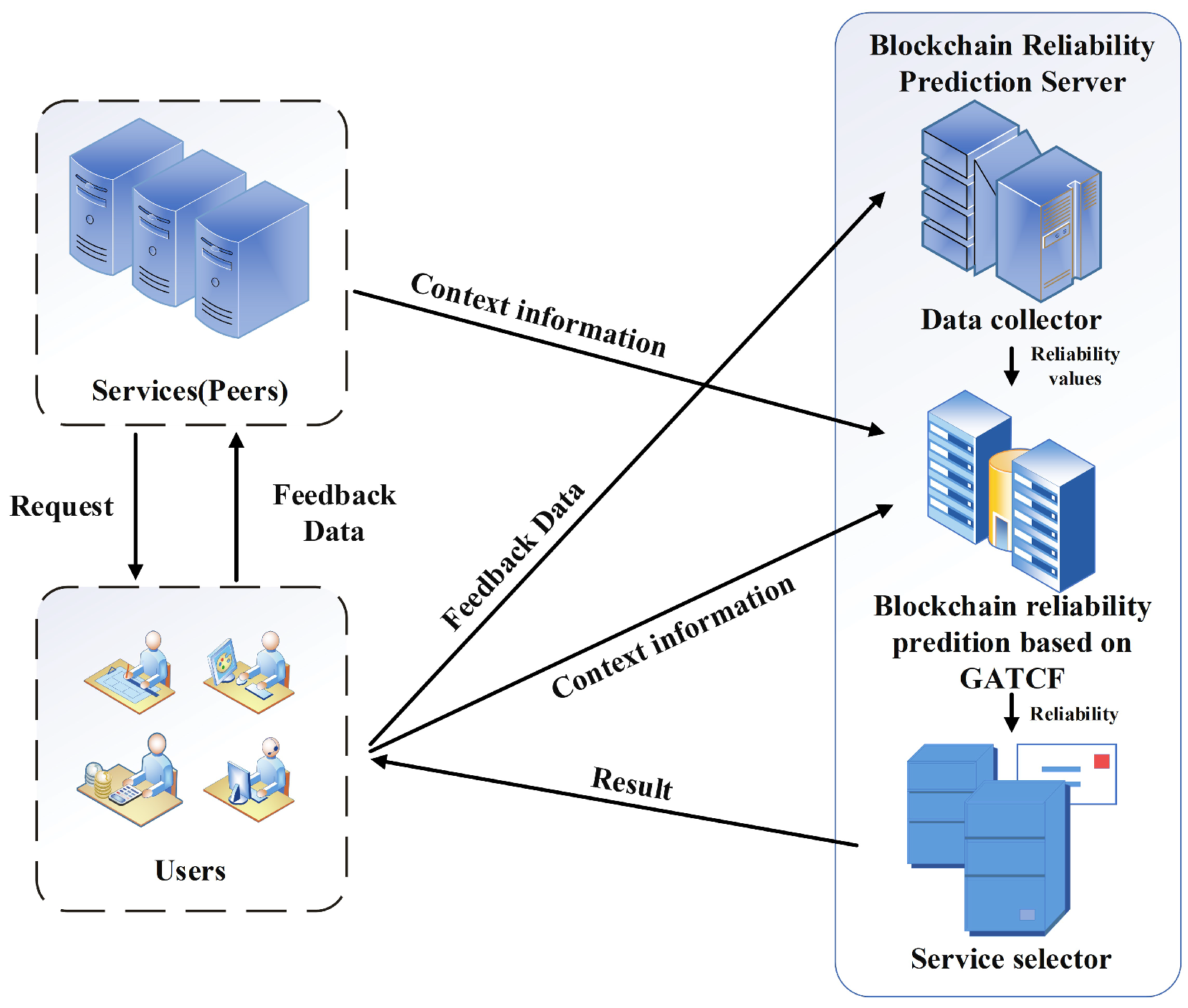
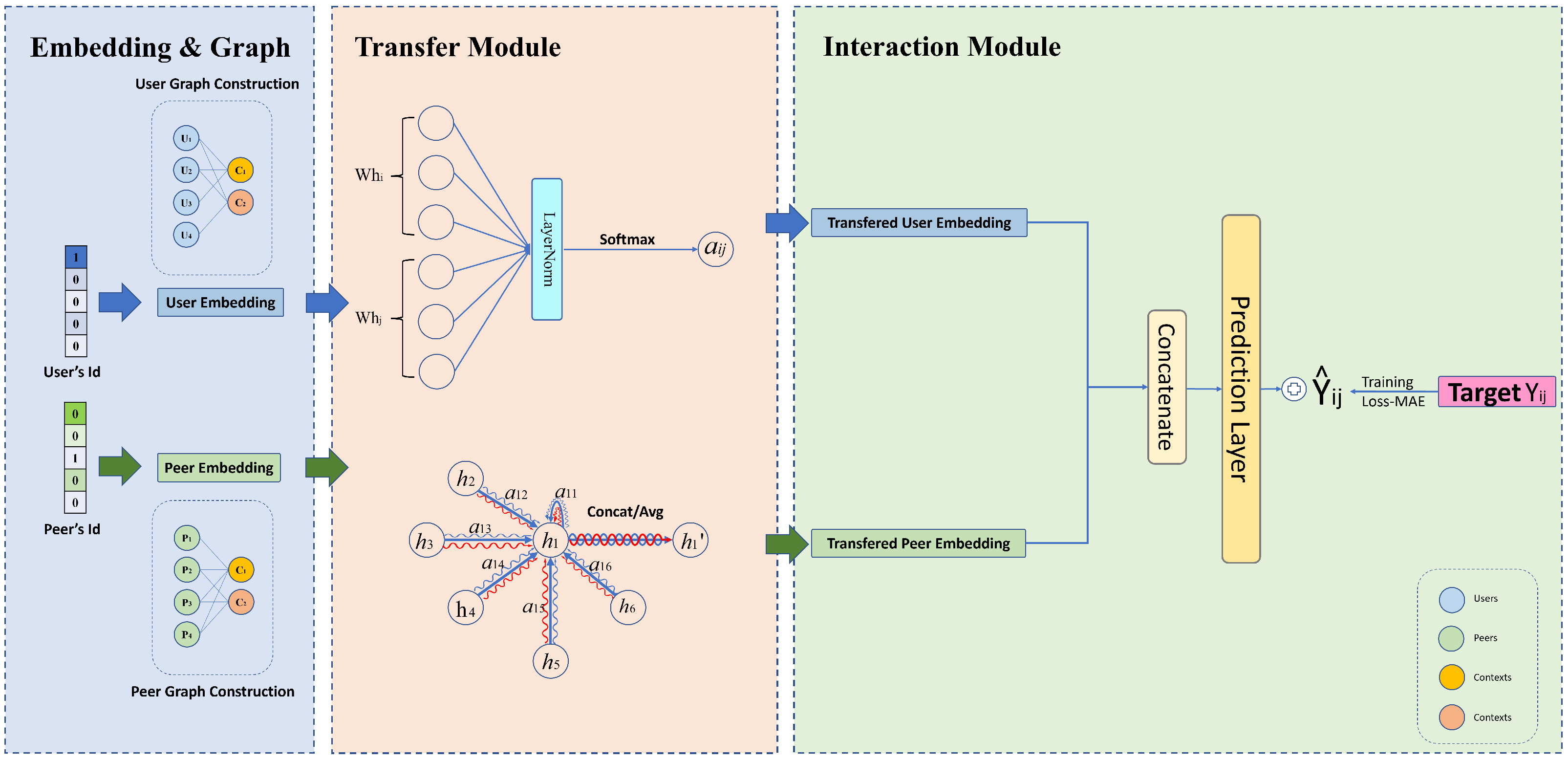
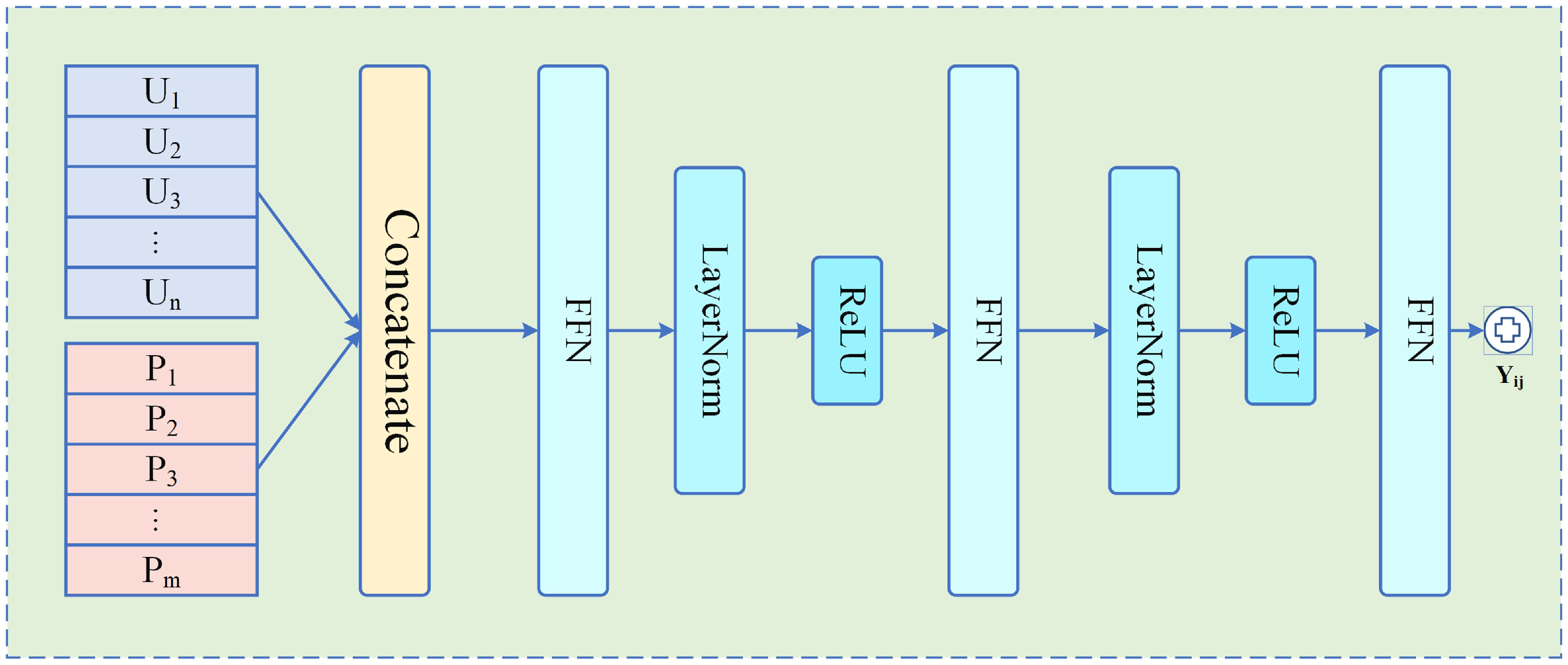
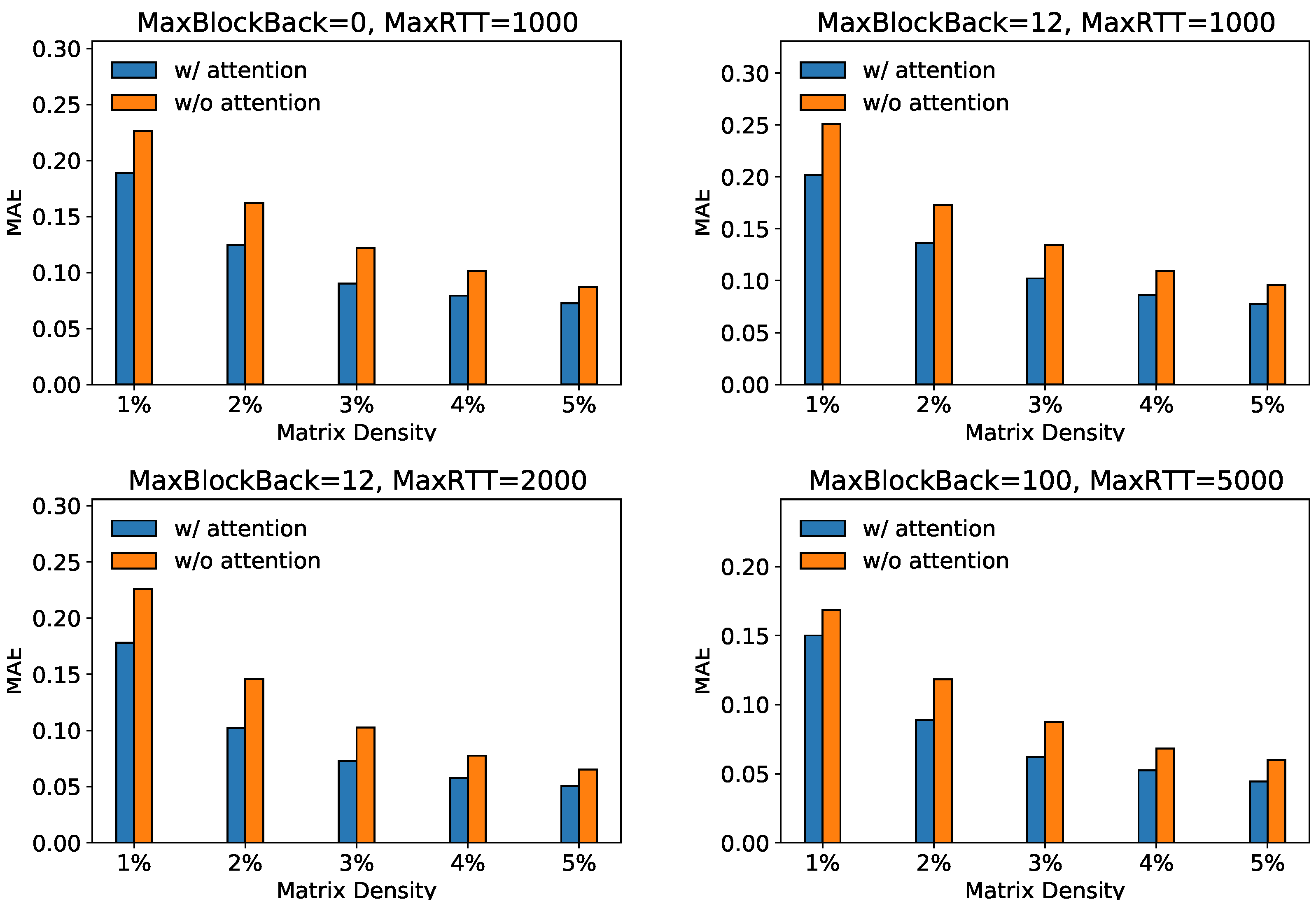

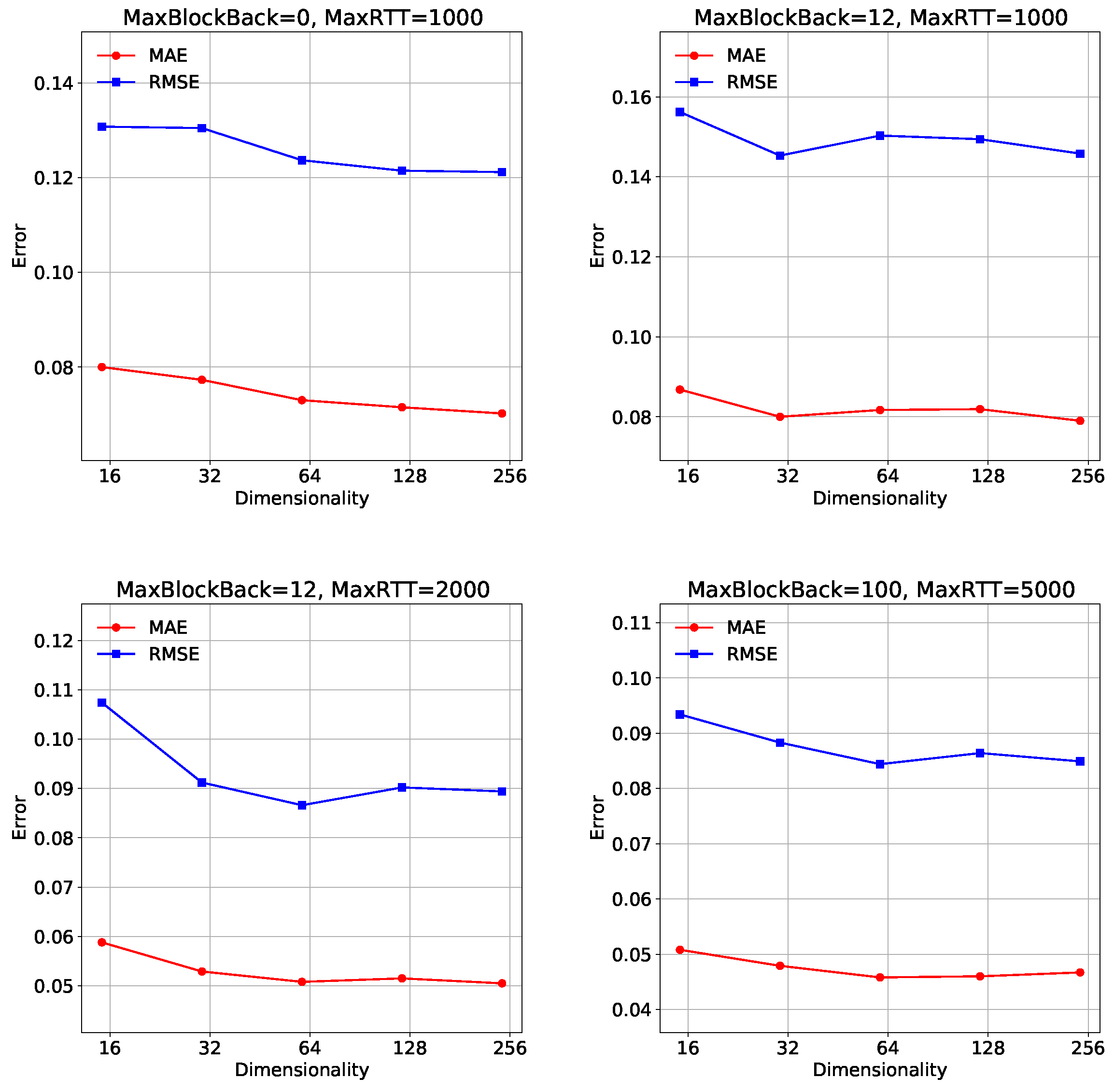
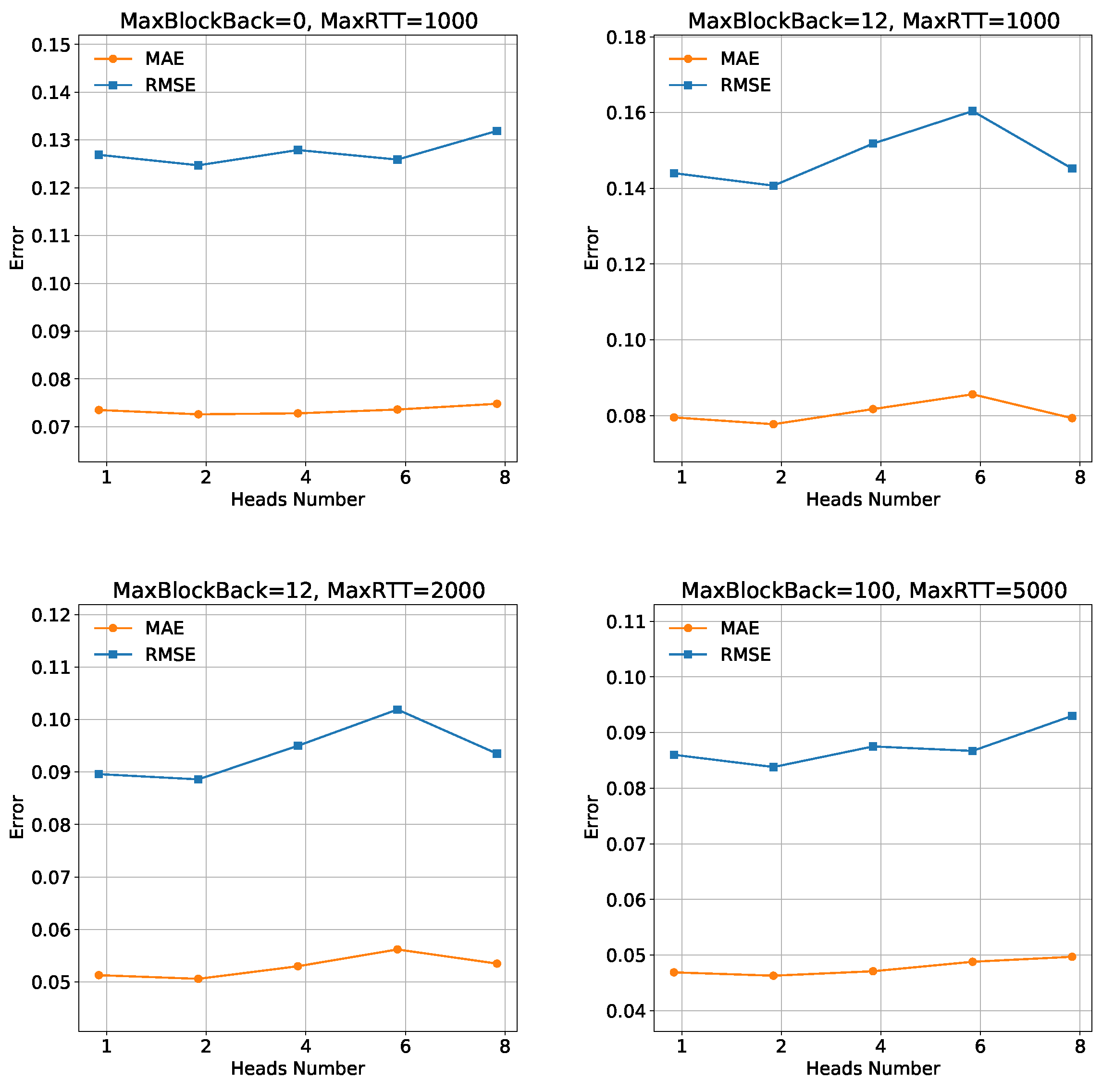
| Method | Advantages | Limitations |
|---|---|---|
| Memory-based | - Simple and easy to implement. - Calculates similarity between users and peers. - Effectively utilizes local information. | - Computation time for similarity in large-scale systems. - Lower prediction performance for sparse datasets. - Suffers from cold-start and scalability problems. |
| Model-based | - Ability to utilize global information. - Capture potential features of users and peers. | - Need for large amounts of training data. - High computational complexity, and difficulty in handling dynamically changing reliability data. |
| Hybrid approaches | - Combination of memory-based and model-based methods. - Estimation of the overall structure. | - Increases the complexity of the model. - Requires tuning of more parameters. |
| Graph neural networks | - Better capture of graph structure features. - Advanced performance in collaborative filtering. | - Requirement of significant computational resources and training data. - Lower prediction performance for sparse datasets. |
| Attention mechanism | - Effective capture of node relationships and importance. - Excellent performance in multiple domains. | - Requirement of significant computational resources and training data. |
| Notation | Definition |
|---|---|
| The SuccessRate of user i to peer j. | |
| All the trainable weights in the matrix completion model. | |
| The learned representation (i.e., embedding) of user i. | |
| The learned representation of service j. | |
| The similarity between two peers. | |
| The interaction function of different models. | |
| The set of neighboring nodes connected to a given node i. | |
| The initial feature vector of the user node. | |
| The initial feature vector of the service node. | |
| The user’s embedding vector. | |
| The peer’s embedding vector. | |
| The LeakyReLU activation function. | |
| , | The transferred embedding. |
| g | The prediction layer of the model. |
| The trainable parameters of the prediction layer. |
| Dataset Setting | 1 | 2 | 3 | 4 |
|---|---|---|---|---|
| MaxBlockBack | 0 | 12 | 12 | 100 |
| MaxRTT | 1000 | 1000 | 2000 | 5000 |
| Datasets | Model | MAE | RMSE | ||||||||
|---|---|---|---|---|---|---|---|---|---|---|---|
| 1% | 2% | 3% | 4% | 5% | 1% | 2% | 3% | 4% | 5% | ||
| 0–1000 | UMEAN | 0.3782 | 0.3624 | 0.3423 | 0.3349 | 0.3282 | 0.4713 | 0.4421 | 0.4061 | 0.3909 | 0.3787 |
| IMEAN | 0.2027 | 0.1368 | 0.1049 | 0.0799 | 0.0748 | 0.3398 | 0.2582 | 0.2012 | 0.1458 | 0.1320 | |
| UPCC | 0.3782 | 0.3621 | 0.3399 | 0.3257 | 0.3026 | 0.4713 | 0.4419 | 0.4044 | 0.3841 | 0.3591 | |
| IPCC | 0.2027 | 0.1368 | 0.1049 | 0.0794 | 0.0735 | 0.3398 | 0.2583 | 0.2013 | 0.1460 | 0.1325 | |
| UPICC | 0.1987 | 0.1392 | 0.1028 | 0.0874 | 0.0816 | 0.3261 | 0.2470 | 0.1800 | 0.1435 | 0.1312 | |
| PMF | 0.7098 | 0.7057 | 0.7022 | 0.6986 | 0.6954 | 0.7190 | 0.7167 | 0.7148 | 0.7129 | 0.7112 | |
| MF | 0.4155 | 0.2580 | 0.1807 | 0.1465 | 0.1210 | 0.5309 | 0.3794 | 0.2761 | 0.2242 | 0.1760 | |
| MNCF | 0.3894 | 0.1589 | 0.1188 | 0.0910 | 0.0755 | 0.4208 | 0.2565 | 0.2048 | 0.1651 | 0.1420 | |
| MFGM | 0.4145 | 0.3213 | 0.1875 | 0.1144 | 0.0854 | 0.5364 | 0.4447 | 0.2755 | 0.1694 | 0.1276 | |
| GraphMF | 0.2249 | 0.1514 | 0.1085 | 0.0910 | 0.0796 | 0.3026 | 0.2256 | 0.1687 | 0.1419 | 0.1278 | |
| GATCF | 0.1886 | 0.1242 | 0.0901 | 0.0793 | 0.0726 | 0.2777 | 0.2052 | 0.1682 | 0.1332 | 0.1247 | |
| 12–1000 | UMEAN | 0.4297 | 0.4033 | 0.3781 | 0.3667 | 0.3604 | 0.5337 | 0.4936 | 0.4503 | 0.4270 | 0.4131 |
| IMEAN | 0.2701 | 0.1728 | 0.1227 | 0.0974 | 0.0869 | 0.4333 | 0.3211 | 0.2377 | 0.1866 | 0.1612 | |
| UPCC | 0.4296 | 0.4031 | 0.3758 | 0.3585 | 0.3345 | 0.5337 | 0.4935 | 0.4487 | 0.4210 | 0.3938 | |
| IPCC | 0.2701 | 0.1728 | 0.1228 | 0.0977 | 0.0879 | 0.4333 | 0.3211 | 0.2377 | 0.1867 | 0.1615 | |
| UPICC | 0.2645 | 0.1748 | 0.1296 | 0.1067 | 0.0973 | 0.4138 | 0.3048 | 0.2276 | 0.1813 | 0.1587 | |
| PMF | 0.7633 | 0.7615 | 0.7570 | 0.7519 | 0.7438 | 0.7749 | 0.7739 | 0.7715 | 0.7687 | 0.7668 | |
| MF | 0.5496 | 0.3047 | 0.1997 | 0.1607 | 0.1455 | 0.6648 | 0.4630 | 0.2992 | 0.2367 | 0.2048 | |
| MNCF | 0.4107 | 0.1928 | 0.1389 | 0.1041 | 0.0850 | 0.4373 | 0.3124 | 0.2428 | 0.1922 | 0.1651 | |
| MFGM | 0.5380 | 0.4209 | 0.2209 | 0.1439 | 0.0918 | 0.6644 | 0.5448 | 0.3050 | 0.2041 | 0.1357 | |
| GraphMF | 0.2545 | 0.1930 | 0.1162 | 0.0982 | 0.0809 | 0.3493 | 0.2780 | 0.1914 | 0.1589 | 0.1403 | |
| GATCF | 0.2017 | 0.1361 | 0.1022 | 0.0861 | 0.0777 | 0.3025 | 0.2305 | 0.1835 | 0.1567 | 0.1281 | |
| 12–2000 | UMEAN | 0.4455 | 0.4010 | 0.3765 | 0.3645 | 0.3613 | 0.5505 | 0.4916 | 0.4479 | 0.4245 | 0.4162 |
| IMEAN | 0.2676 | 0.1399 | 0.0854 | 0.0624 | 0.0535 | 0.4442 | 0.2913 | 0.1949 | 0.1320 | 0.1069 | |
| UPCC | 0.4455 | 0.4006 | 0.3736 | 0.3541 | 0.3312 | 0.5505 | 0.4913 | 0.4458 | 0.4168 | 0.3937 | |
| IPCC | 0.2676 | 0.1399 | 0.0855 | 0.0626 | 0.0541 | 0.4442 | 0.2913 | 0.1949 | 0.1320 | 0.1072 | |
| UPICC | 0.2652 | 0.1455 | 0.0959 | 0.0752 | 0.0665 | 0.4246 | 0.2762 | 0.1871 | 0.1311 | 0.1089 | |
| PMF | 0.7878 | 0.7815 | 0.7763 | 0.7722 | 0.7671 | 0.7923 | 0.7889 | 0.7862 | 0.7840 | 0.7813 | |
| MF | 0.5878 | 0.3048 | 0.1832 | 0.1325 | 0.1164 | 0.6985 | 0.4501 | 0.2927 | 0.2050 | 0.1668 | |
| MNCF | 0.4134 | 0.1998 | 0.1351 | 0.0961 | 0.0754 | 0.4399 | 0.3204 | 0.2381 | 0.1856 | 0.1490 | |
| MFGM | 0.5796 | 0.4087 | 0.2130 | 0.1058 | 0.0653 | 0.6953 | 0.5267 | 0.2935 | 0.1474 | 0.0916 | |
| GraphMF | 0.2437 | 0.1531 | 0.0931 | 0.0699 | 0.0547 | 0.3357 | 0.2409 | 0.1507 | 0.1072 | 0.0897 | |
| GATCF | 0.1782 | 0.1022 | 0.0730 | 0.0576 | 0.0506 | 0.2847 | 0.1871 | 0.1372 | 0.1037 | 0.0886 | |
| 100–5000 | UMEAN | 0.4130 | 0.3252 | 0.2749 | 0.2635 | 0.2555 | 0.5293 | 0.4317 | 0.3592 | 0.3382 | 0.3253 |
| IMEAN | 0.3178 | 0.1561 | 0.0860 | 0.0686 | 0.0511 | 0.5001 | 0.3261 | 0.2037 | 0.1625 | 0.1114 | |
| UPCC | 0.4129 | 0.3249 | 0.2729 | 0.2572 | 0.2360 | 0.5293 | 0.4315 | 0.3576 | 0.3329 | 0.3089 | |
| IPCC | 0.3178 | 0.1561 | 0.0861 | 0.0589 | 0.0494 | 0.5001 | 0.3261 | 0.2037 | 0.1318 | 0.1065 | |
| UPICC | 0.3102 | 0.1568 | 0.0907 | 0.0643 | 0.0560 | 0.4724 | 0.3041 | 0.1912 | 0.1274 | 0.1049 | |
| PMF | 0.7991 | 0.7915 | 0.7904 | 0.7877 | 0.7832 | 0.8052 | 0.8012 | 0.8006 | 0.7992 | 0.7968 | |
| MF | 0.7093 | 0.3175 | 0.1895 | 0.1371 | 0.1172 | 0.7804 | 0.4609 | 0.3012 | 0.2000 | 0.1575 | |
| MNCF | 0.4041 | 0.2221 | 0.1573 | 0.1050 | 0.0788 | 0.4345 | 0.3446 | 0.2716 | 0.1990 | 0.1586 | |
| MFGM | 0.7039 | 0.4324 | 0.2033 | 0.0944 | 0.0636 | 0.7815 | 0.5255 | 0.2616 | 0.1259 | 0.0884 | |
| GraphMF | 0.1954 | 0.1568 | 0.0878 | 0.0715 | 0.0459 | 0.2935 | 0.2465 | 0.1521 | 0.1157 | 0.0780 | |
| GATCF | 0.1501 | 0.0890 | 0.0624 | 0.0525 | 0.0444 | 0.2433 | 0.1610 | 0.1172 | 0.0982 | 0.0753 | |
Disclaimer/Publisher’s Note: The statements, opinions and data contained in all publications are solely those of the individual author(s) and contributor(s) and not of MDPI and/or the editor(s). MDPI and/or the editor(s) disclaim responsibility for any injury to people or property resulting from any ideas, methods, instructions or products referred to in the content. |
© 2023 by the authors. Licensee MDPI, Basel, Switzerland. This article is an open access article distributed under the terms and conditions of the Creative Commons Attribution (CC BY) license (https://creativecommons.org/licenses/by/4.0/).
Share and Cite
Zeng, Y.; Xu, J.; Zhang, Z.; Chen, C.; Ling, Q.; Wang, J. GATCF: Graph Attention Collaborative Filtering for Reliable Blockchain Services Selection in BaaS. Sensors 2023, 23, 6775. https://doi.org/10.3390/s23156775
Zeng Y, Xu J, Zhang Z, Chen C, Ling Q, Wang J. GATCF: Graph Attention Collaborative Filtering for Reliable Blockchain Services Selection in BaaS. Sensors. 2023; 23(15):6775. https://doi.org/10.3390/s23156775
Chicago/Turabian StyleZeng, Yuxiang, Jianlong Xu, Zhuohua Zhang, Caiyi Chen, Qianyu Ling, and Jialin Wang. 2023. "GATCF: Graph Attention Collaborative Filtering for Reliable Blockchain Services Selection in BaaS" Sensors 23, no. 15: 6775. https://doi.org/10.3390/s23156775
APA StyleZeng, Y., Xu, J., Zhang, Z., Chen, C., Ling, Q., & Wang, J. (2023). GATCF: Graph Attention Collaborative Filtering for Reliable Blockchain Services Selection in BaaS. Sensors, 23(15), 6775. https://doi.org/10.3390/s23156775






